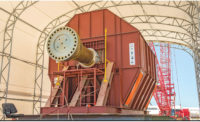...which regulates the nation’s 104 nuclear powerplants, will carefully consider potential changes to the nation’s reactors but won’t act hastily.
“There is a tendency to look at the moment and make a snap decision. That’s not the way the [NRC] works,” he says. Merrifield says that, after 9/11, there was a public outcry for more protection of nuclear power plants against terrorists threats. “There were calls for adding batteries of missiles, adding large monoliths surrounding the site. There were a lot of exotic ideas,” he says.
After examining the plants, the NRC called for redundancy of A/C power, additional measures for core cooling, emergency diesel generators and upgrades to security at the plants. Many of those measures would help mitigate a Fukushima-like event, Merrifield says.
Merrifield doesn’t believe U.S. plants need upgrades for higher seismic forces or tsunami waves. “The design parameters the NRC uses are very stringent. I don’t foresee that as a change,” he said.
The NRC determines how much of a seismic threat a nuclear plant should be able to withstand by examining the quake history in that location. Then, it adds a conservative extra measure, he says.
But that standard isn’t static. The U.S. Geological Survey, NRC and others periodically update the hazard risks based on more recent seismic activity, says Neil Wilmshurst, vice president, nuclear, for the Electric Power Research Institute, an independent non-profit research and development arm of the electric industry. Nuclear plants are then checked to make sure they can still withstand the updated standards.
“In most cases, no changes are made,” he says. But sometimes changes are needed, such as equipment being better anchored or equipment getting upgraded, Wadley says.
The Diablo Canyon nuclear plant went through a major redesign and retrofit in 1977 after the Hosgri fault was discovered off the coast. The operator placed buttresses on turbine buildings and beefed up supports, Cluff says. The original containment design was determined to be acceptable. The plant’s backup generators are 85 ft above grade, allowing them to survive any tsunami, he says.
The NRC, in its post-Fukushima analysis, will likely scrutinize the 23 boiling-water reactors (BWR) in the U.S.—the same design as the crippled reactors in Japan. In a statement, Mike Tetuan, spokesman for GE Hitachi Nuclear Energy, the BWR Mark 1 “the industry’s workhorse with a proven track record”—and one that has never had a breach of its containment system.
Going forward, the event’s repercussions could be traumatic for an expanding nuclear industry. The last boom in U.S. nuclear construction was killed after the 1979 Three Mile Island nuclear accident. NEI says that lessons learned from that accident made the industry safer.
But politicians and the public may be hard to convince. Sen. Joe Lieberman (I-Conn.) wants a moratorium on new nuclear reactors, and Rep. Edward Markey (D-Mass.) is calling for a reexamination of the existing plants. Environmental groups are arguing the accident in Japan is evidence that nuclear powerplants aren’t safe.
A House Energy and Commerce Committee hearing was scheduled for March 16. The hearing was called before March 11 by Rep. Fred Upton (R-Mich.), chairman of the committee. He requested that NRC Chairman Gregory Jaczko attend the hearing to explain delays in licensing new plants and relicensing existing plants. Sen. Barbara Boxer (D- Calif.) also has called Jaczko to a briefing in front of the Senate Committee on Environment and Public Works on Wednesday afternoon.
In a worst-case scenario, Congress could withhold funding for Atlanta-based Southern Cos.’ Vogtle Units 3 and 4 in Georgia. The government’s $8.3-billion loan guarantee isn’t final until Southern receives a construction and operating license. A spokeswoman says Southern has no indication the Japanese event will affect the licensing process.
Nuclear Innovation North America’s South Texas Project in Matagorda County, Texas, may be most at risk. That project, a joint venture between NRG Energy and Tokyo-based Toshiba, had applied to use Toshiba-designed advanced boiling-water reactors at the site. Toshiba supplied the GE-designed BWR Fukushima Daiichi Unit 3. Additionally, the TEPCO, owner of the Fukushima plant, agreed last May to pay NINA up to $125 million for a 10% share in the venture.
On March 15, San Antonio-based municipal utility CPS Energy suspended talks with NRG for the prospective purchase of power from the proposed plants. In a written statement, CPS said the utility and NRG “decided today by mutual agreement that, until more information is available about the situation in Japan and its impact on the industry worldwide, it makes sense to put our purchase power agreement discussions on hold.”
Despite continued support from the Obama administration, financial markets could turn against nuclear companies. Standard & Poor’s said on March 14 that the disaster makes higher costs and more oversight probable, with the greatest threat to merchant generators who can’t recover their costs from their rate base. S&P, like Engineering News-Record, is part of The McGraw-Hill Cos.
“Heightened public awareness of nuclear power risks and requirements for greater safety provisions may also affect relicensing efforts and new nuclear plant construction,” the report added.
Avram Fisher, industry analyst for BMO Capital Markets, New York City, says, “[Investors] considering a swing in the pendulum toward coal over nuclear” may consider selling holdings of The Shaw Group, which he says is “the largest nuclear-exposed” E&C firm.
J.M. Bernhard Jr., the chairman, president and CEO of The Shaw Group, which is building two AP1000 units at Vogtle and two others in South Carolina, said in a statement that he did not believe Shaw’s projects in the U.S. and China would be negatively affected. “Our customers have indicated they intend to move forward, and we believe the construction timelines will continue as planned,” Bernhard said.








